boot SKODA OCTAVIA 2005 1.G / (1U) User Guide
[x] Cancel search | Manufacturer: SKODA, Model Year: 2005, Model line: OCTAVIA, Model: SKODA OCTAVIA 2005 1.G / (1U)Pages: 315, PDF Size: 11.8 MB
Page 67 of 315
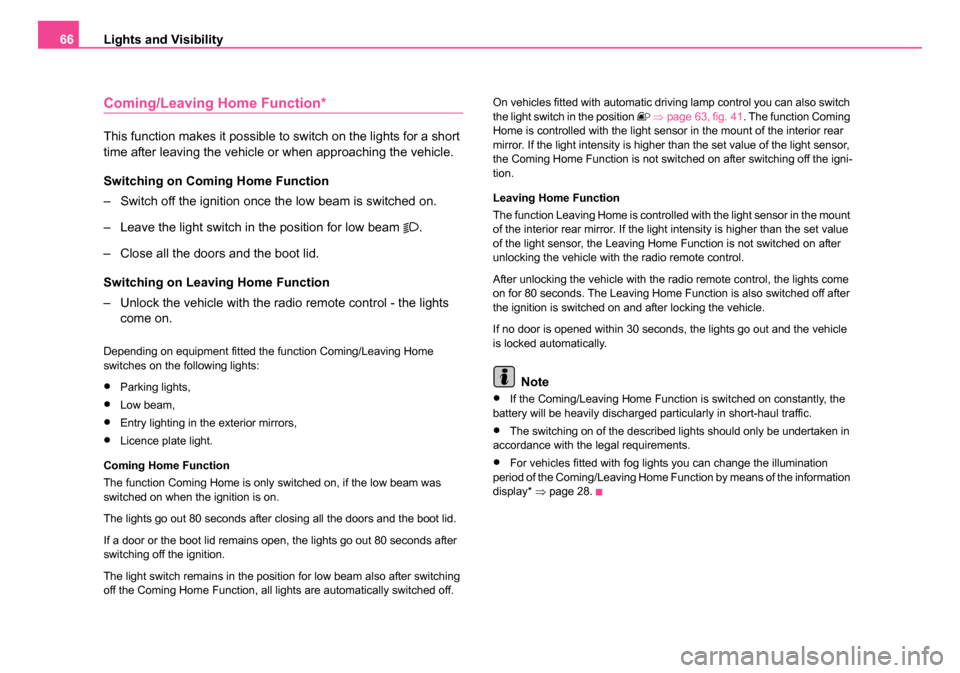
Lights and Visibility
66
Coming/Leaving Home Function*
This function makes it possible to switch on the lights for a short
time after leaving the vehicle or when approaching the vehicle.
Switching on Coming Home Function
– Switch off the ignition once the low beam is switched on.
– Leave the light switch in the position for low beam
.
– Close all the doors and the boot lid.
Switching on Leaving Home Function
– Unlock the vehicle with the radio remote control - the lights come on.
Depending on equipment fitted the function Coming/Leaving Home
switches on the following lights:
•Parking lights,
•Low beam,
•Entry lighting in the exterior mirrors,
•Licence plate light.
Coming Home Function
The function Coming Home is only switched on, if the low beam was
switched on when the ignition is on.
The lights go out 80 seconds after closing all the doors and the boot lid.
If a door or the boot lid remains open, the lights go out 80 seconds after
switching off the ignition.
The light switch remains in the position for low beam also after switching
off the Coming Home Function, all lights are automatically switched off. On vehicles fitted with automatic driving lamp control you can also switch
the light switch in the position
⇒ page 63, fig. 41 . The function Coming
Home is controlled with the light sensor in the mount of the interior rear
mirror. If the light intensity is higher than the set value of the light sensor,
the Coming Home Function is not switched on after switching off the igni-
tion.
Leaving Home Function
The function Leaving Home is controlled with the light sensor in the mount
of the interior rear mirror. If the light intensity is higher than the set value
of the light sensor, the Leaving Home Function is not switched on after
unlocking the vehicle with the radio remote control.
After unlocking the vehicle with the radio remote control, the lights come
on for 80 seconds. The Leaving Home Function is also switched off after
the ignition is switched on and after locking the vehicle.
If no door is opened within 30 seconds, the lights go out and the vehicle
is locked automatically.
Note
•If the Coming/Leaving Home Function is switched on constantly, the
battery will be heavily discharged particularly in short-haul traffic.
•The switching on of the described lights should only be undertaken in
accordance with the legal requirements.
•For vehicles fitted with fog lights you can change the illumination
period of the Coming/Leaving Home Function by means of the information
display* ⇒page 28.
s24s.book Page 66 Thursday, November 24, 2005 12:27 PM
Page 72 of 315
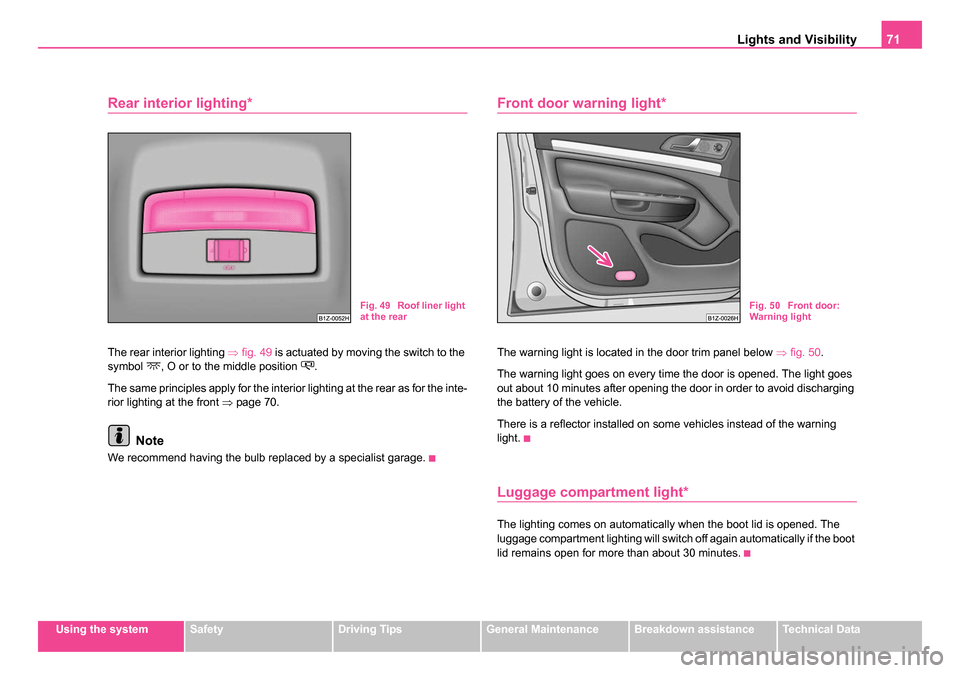
Lights and Visibility71
Using the systemSafetyDriving TipsGeneral MaintenanceBreakdown assistanceTechnical Data
Rear interior lighting*
The rear interior lighting ⇒fig. 49 is actuated by moving the switch to the
symbol , O or to the middle position .
The same principles apply for the interior lighting at the rear as for the inte-
rior lighting at the front ⇒ page 70.
Note
We recommend having the bulb replaced by a specialist garage.
Front door warning light*
The warning light is located in the door trim panel below ⇒fig. 50 .
The warning light goes on every time the door is opened. The light goes
out about 10 minutes after opening the door in order to avoid discharging
the battery of the vehicle.
There is a reflector installed on some vehicles instead of the warning
light.
Luggage compartment light*
The lighting comes on automatically when the boot lid is opened. The
luggage compartment lighting will switch off again automatically if the boot
lid remains open for more than about 30 minutes.
Fig. 49 Roof liner light
at the rearFig. 50 Front door:
Warning light
s24s.book Page 71 Thursday, November 24, 2005 12:27 PM
Page 73 of 315
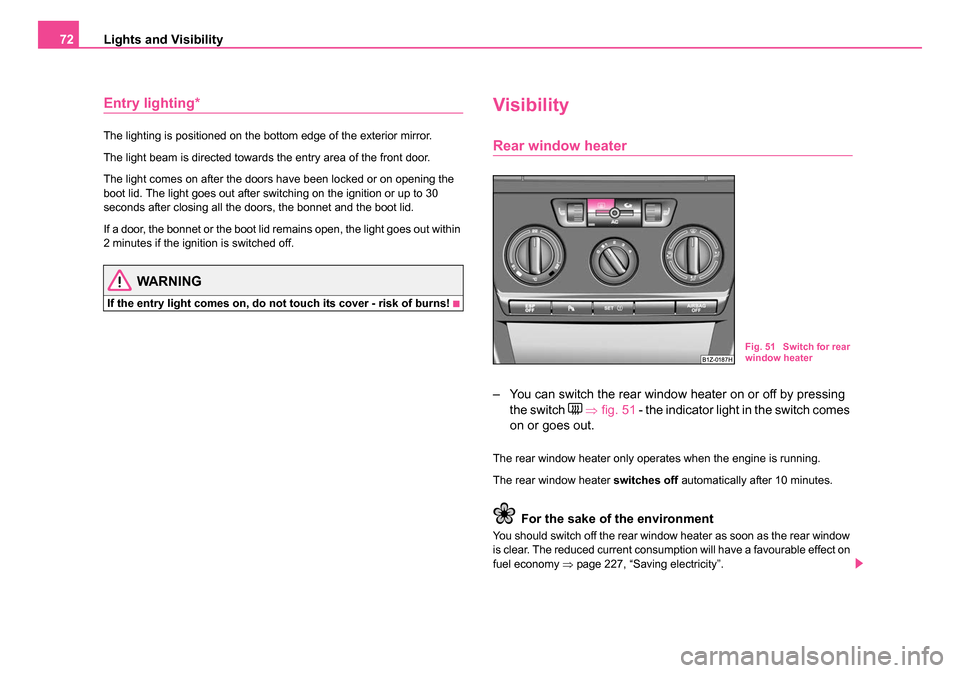
Lights and Visibility
72
Entry lighting*
The lighting is positioned on the bottom edge of the exterior mirror.
The light beam is directed towards the entry area of the front door.
The light comes on after the doors have been locked or on opening the
boot lid. The light goes out after switching on the ignition or up to 30
seconds after closing all the doors, the bonnet and the boot lid.
If a door, the bonnet or the boot lid remains open, the light goes out within
2 minutes if the ignition is switched off.
WARNING
If the entry light comes on, do not touch its cover - risk of burns!
Visibility
Rear window heater
– You can switch the rear window heater on or off by pressing
the switch
⇒ fig. 51 - the indicator light in the switch comes
on or goes out.
The rear window heater only operates when the engine is running.
The rear window heater switches off automatically after 10 minutes.
For the sake of the environment
You should switch off the rear window heater as soon as the rear window
is clear. The reduced current consumption will have a favourable effect on
fuel economy ⇒page 227, “Saving electricity”.
Fig. 51 Switch for rear
window heater
s24s.book Page 72 Thursday, November 24, 2005 12:27 PM
Page 93 of 315
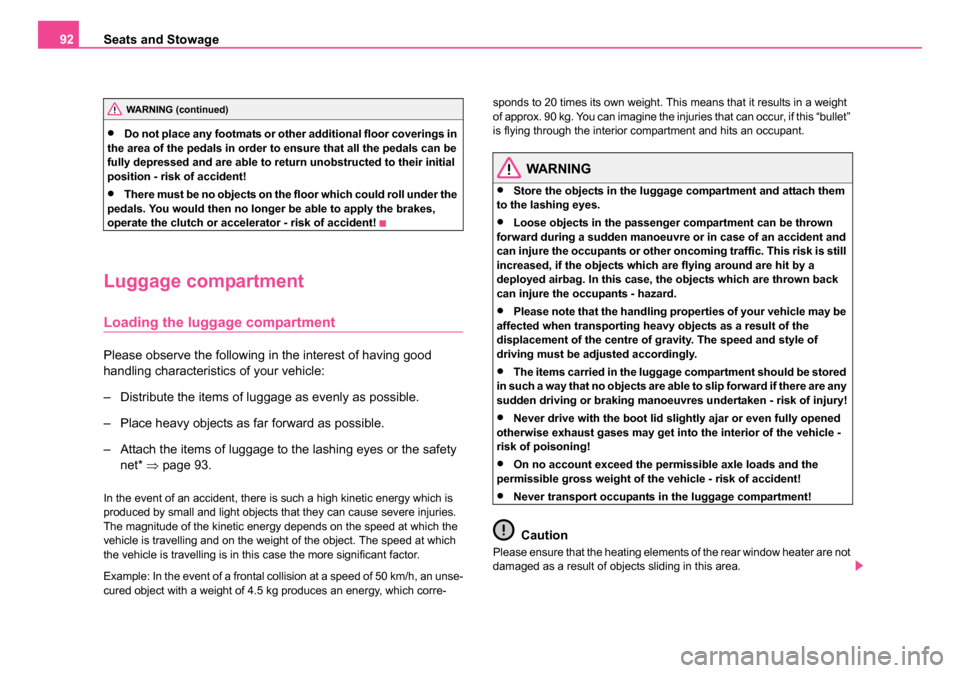
Seats and Stowage
92
•Do not place any footmats or other additional floor coverings in
the area of the pedals in order to ensure that all the pedals can be
fully depressed and are able to return unobstructed to their initial
position - risk of accident!
•There must be no objects on the floor which could roll under the
pedals. You would then no longer be able to apply the brakes,
operate the clutch or accelerator - risk of accident!
Luggage compartment
Loading the luggage compartment
Please observe the following in the interest of having good
handling characteristics of your vehicle:
– Distribute the items of luggage as evenly as possible.
– Place heavy objects as far forward as possible.
– Attach the items of luggage to the lashing eyes or the safety net* ⇒page 93.
In the event of an accident, there is such a high kinetic energy which is
produced by small and light objects that they can cause severe injuries.
The magnitude of the kinetic energy depends on the speed at which the
vehicle is travelling and on the weight of the object. The speed at which
the vehicle is travelling is in this case the more significant factor.
Example: In the event of a frontal collision at a speed of 50 km/h, an unse-
cured object with a weight of 4.5 kg produces an energy, which corre- sponds to 20 times its own weight. This means that it results in a weight
of approx. 90 kg. You can imagine the injuries that can occur, if this “bullet”
is flying through the interior compartment and hits an occupant.
WARNING
•Store the objects in the luggage compartment and attach them
to the lashing eyes.
•Loose objects in the passenger compartment can be thrown
forward during a sudden manoeuvre or in case of an accident and
can injure the occupants or other oncoming traffic. This risk is still
increased, if the objects which are flying around are hit by a
deployed airbag. In this case, the objects which are thrown back
can injure the occupants - hazard.
•Please note that the handling properties of your vehicle may be
affected when transporting heavy objects as a result of the
displacement of the centre of gravity. The speed and style of
driving must be adjusted accordingly.
•The items carried in the luggage compartment should be stored
in such a way that no objects are able to slip forward if there are any
sudden driving or braking manoeuvres undertaken - risk of injury!
•Never drive with the boot lid sli ghtly ajar or even fully opened
otherwise exhaust gases may get into the interior of the vehicle -
risk of poisoning!
•On no account exceed the permissible axle loads and the
permissible gross weight of th e vehicle - risk of accident!
•Never transport occupants in the luggage compartment!
Caution
Please ensure that the heating elements of the rear window heater are not
damaged as a result of objects sliding in this area.
WARNING (continued)
s24s.book Page 92 Thursday, November 24, 2005 12:27 PM
Page 98 of 315
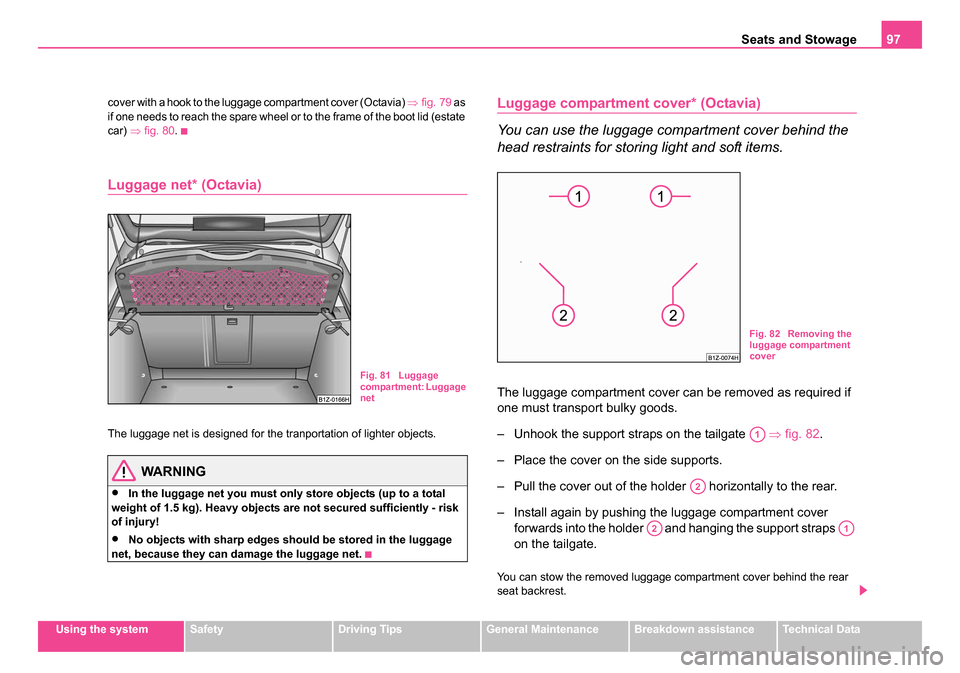
Seats and Stowage97
Using the systemSafetyDriving TipsGeneral MaintenanceBreakdown assistanceTechnical Data
cover with a hook to the luggage compartment cover (Octavia)
⇒fig. 79 as
if one needs to reach the spare wheel or to the frame of the boot lid (estate
car) ⇒fig. 80 .
Luggage net* (Octavia)
The luggage net is designed for the tranportation of lighter objects.
WARNING
•In the luggage net you must only store objects (up to a total
weight of 1.5 kg). Heavy objects are not secured sufficiently - risk
of injury!
•No objects with sharp edges should be stored in the luggage
net, because they can damage the luggage net.
Luggage compartment cover* (Octavia)
You can use the luggage compartment cover behind the
head restraints for storing light and soft items.
The luggage compartment cover can be removed as required if
one must transport bulky goods.
– Unhook the support straps on the tailgate ⇒fig. 82.
– Place the cover on the side supports.
– Pull the cover out of the holder horizontally to the rear.
– Install again by pushing the luggage compartment cover forwards into the holder and hanging the support straps
on the tailgate.
You can stow the removed luggage compartment cover behind the rear
seat backrest.
Fig. 81 Luggage
compartment: Luggage
net
Fig. 82 Removing the
luggage compartment
cover
A1
A2
A2A1
s24s.book Page 97 Thursday, November 24, 2005 12:27 PM
Page 116 of 315
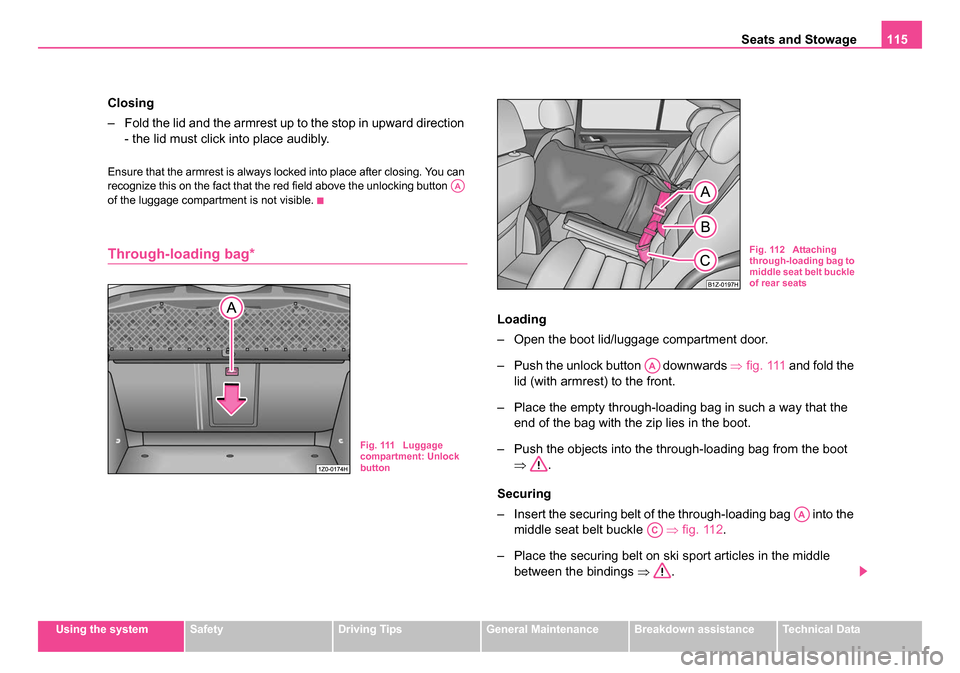
Seats and Stowage115
Using the systemSafetyDriving TipsGeneral MaintenanceBreakdown assistanceTechnical Data
Closing
– Fold the lid and the armrest up to the stop in upward direction
- the lid must click into place audibly.
Ensure that the armrest is always locked into place after closing. You can
recognize this on the fact that the red field above the unlocking button
of the luggage compartment is not visible.
Through-loading bag*
Loading
– Open the boot lid/luggage compartment door.
– Push the unlock button downwards ⇒fig. 111 and fold the
lid (with armrest) to the front.
– Place the empty through-loading bag in such a way that the end of the bag with the zip lies in the boot.
– Push the objects into the through-loading bag from the boot ⇒ .
Securing
– Insert the securing belt of the through-loading bag into the middle seat belt buckle ⇒fig. 112 .
– Place the securing belt on ski sport articles in the middle between the bindings ⇒.
AA
Fig. 111 Luggage
compartment: Unlock
button
Fig. 112 Attaching
through-loading bag to
middle seat belt buckle
of rear seats
AA
AA
AC
s24s.book Page 115 Thursday, November 24, 2005 12:27 PM
Page 238 of 315

Taking care of your vehicle and cleaning the vehicle 237
Using the systemSafetyDriving TipsGeneral MaintenanceBreakdown assistanceTechnical Data
Caution
Never remove snow or ice from the glass parts with warm or hot water -
risk of formation of cracks in the glass!
The headlight lenses
Please do not use any aggressive cleaning or chemical solvent products
- risk of damage to the plastic lenses Please use soap and clean warm
water.
Caution
Never wipe the headlights dry and do not use any sharp objects for
cleaning the plastic lenses, this may result in damage to the protective
paintwork and consequently in formation of cracks on the headlight
lenses, e.g through effect of chemical products.
Door and window seals
The rubber seals on the doors, boot lid, bonnet, sliding roof and windows
remain supple and last longer if you treat them from time to time with a
rubber care product (e.g. silicone spray). You also avoid premature wear
of the seals and prevent leakages in this way. It is also easier to open the
doors. Rubber seals which are well cared for also do not stick together in
cold winter weather.
Locks
We recommend that you use the spray from Škoda original accessories
with regreasing and anticorrosive effect for de-icing locks.
Note
When washing your vehicle, ensure that as little water as possible gets
into the locks.
Wheels
Steel wheels
You should also thoroughly wash the wheels and wheel trims when giving
your vehicle its regular wash. This prevents any brake dust, dirt and road
salt from sticking to the wheel hubs. You can remove stubborn brake abra-
sion adhering to the wheels with an industrial cleaner. Touch up any
damage to the paintwork on the wheels before rust is able to form.
Light alloy wheels
Regular care of light alloy wheels is necessary in order to retain their
decorative appearance over long periods. It is particularly important to
remove any road salt and brake abrasion from light alloy wheels every two
weeks, otherwise the surface will suffer. Wash thoroughly and then treat
the wheels with a protective product for light alloy wheels which does not
contain any acidic components. You should provide the wheel hubs with
a hard wax layer every three months. You must not use any products
which cause abrasion when treating the wheel hubs. Any damage to the
paint layer on the wheel hubs must be touched up immediately.
We recommend using a preservative from Škoda genuine accessories
offered by your Škoda dealer.
s24s.book Page 237 Thursday, November 24, 2005 12:27 PM
Page 306 of 315
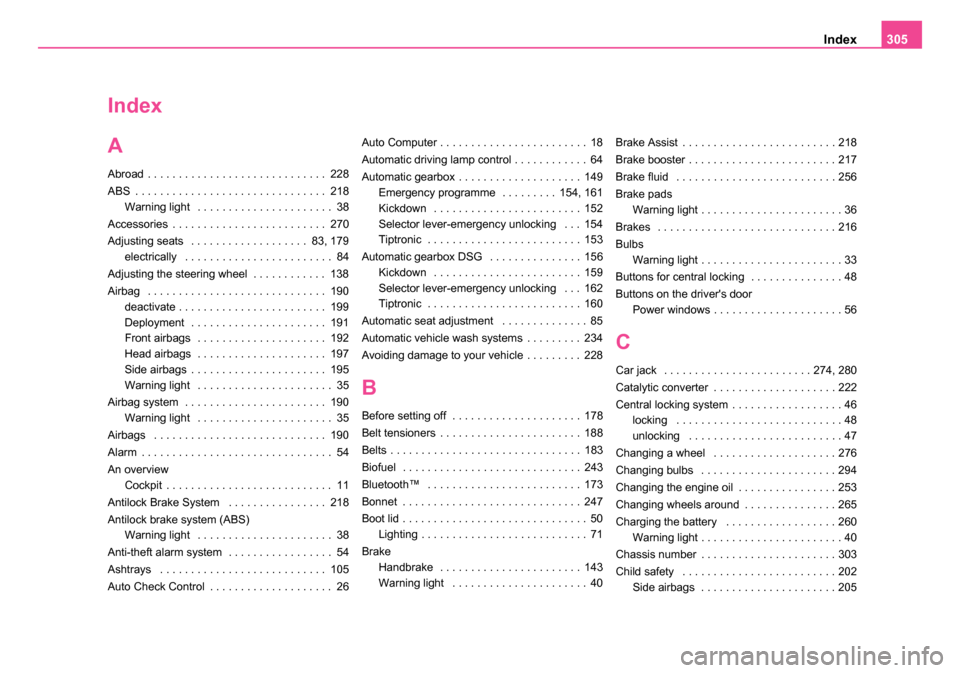
Index305
Index
A
Abroad . . . . . . . . . . . . . . . . . . . . . . . . . . . . . 228
ABS . . . . . . . . . . . . . . . . . . . . . . . . . . . . . . . 218
Warning light . . . . . . . . . . . . . . . . . . . . . . 38
Accessories . . . . . . . . . . . . . . . . . . . . . . . . . 270
Adjusting seats . . . . . . . . . . . . . . . . . . . 83, 179 electrically . . . . . . . . . . . . . . . . . . . . . . . . 84
Adjusting the steering wheel . . . . . . . . . . . . 138
Airbag . . . . . . . . . . . . . . . . . . . . . . . . . . . . . 190 deactivate . . . . . . . . . . . . . . . . . . . . . . . . 199
Deployment . . . . . . . . . . . . . . . . . . . . . . 191
Front airbags . . . . . . . . . . . . . . . . . . . . . 192
Head airbags . . . . . . . . . . . . . . . . . . . . . 197
Side airbags . . . . . . . . . . . . . . . . . . . . . . 195
Warning light . . . . . . . . . . . . . . . . . . . . . . 35
Airbag system . . . . . . . . . . . . . . . . . . . . . . . 190 Warning light . . . . . . . . . . . . . . . . . . . . . . 35
Airbags . . . . . . . . . . . . . . . . . . . . . . . . . . . . 190
Alarm . . . . . . . . . . . . . . . . . . . . . . . . . . . . . . . 54
An overview Cockpit . . . . . . . . . . . . . . . . . . . . . . . . . . . 11
Antilock Brake System . . . . . . . . . . . . . . . . 218
Antilock brake system (ABS) Warning light . . . . . . . . . . . . . . . . . . . . . . 38
Anti-theft alarm system . . . . . . . . . . . . . . . . . 54
Ashtrays . . . . . . . . . . . . . . . . . . . . . . . . . . . 105
Auto Check Control . . . . . . . . . . . . . . . . . . . . 26 Auto Computer . . . . . . . . . . . . . . . . . . . . . . . . 18
Automatic driving lamp control . . . . . . . . . . . . 64
Automatic gearbox . . . . . . . . . . . . . . . . . . . . 149
Emergency programme . . . . . . . . . 154, 161
Kickdown . . . . . . . . . . . . . . . . . . . . . . . . 152
Selector lever-emergency unlocking . . . 154
Tiptronic . . . . . . . . . . . . . . . . . . . . . . . . . 153
Automatic gearbox DSG . . . . . . . . . . . . . . . 156 Kickdown . . . . . . . . . . . . . . . . . . . . . . . . 159
Selector lever-emergency unlocking . . . 162
Tiptronic . . . . . . . . . . . . . . . . . . . . . . . . . 160
Automatic seat adjustment . . . . . . . . . . . . . . 85
Automatic vehicle wash systems . . . . . . . . . 234
Avoiding damage to your vehicle . . . . . . . . . 228
B
Before setting off . . . . . . . . . . . . . . . . . . . . . 178
Belt tensioners . . . . . . . . . . . . . . . . . . . . . . . 188
Belts . . . . . . . . . . . . . . . . . . . . . . . . . . . . . . . 183
Biofuel . . . . . . . . . . . . . . . . . . . . . . . . . . . . . 243
Bluetooth™ . . . . . . . . . . . . . . . . . . . . . . . . . 173
Bonnet . . . . . . . . . . . . . . . . . . . . . . . . . . . . . 247
Boot lid . . . . . . . . . . . . . . . . . . . . . . . . . . . . . . 50 Lighting . . . . . . . . . . . . . . . . . . . . . . . . . . . 71
Brake Handbrake . . . . . . . . . . . . . . . . . . . . . . . 143
Warning light . . . . . . . . . . . . . . . . . . . . . . 40 Brake Assist . . . . . . . . . . . . . . . . . . . . . . . . . 218
Brake booster . . . . . . . . . . . . . . . . . . . . . . . . 217
Brake fluid . . . . . . . . . . . . . . . . . . . . . . . . . . 256
Brake pads
Warning light . . . . . . . . . . . . . . . . . . . . . . . 36
Brakes . . . . . . . . . . . . . . . . . . . . . . . . . . . . . 216
Bulbs Warning light . . . . . . . . . . . . . . . . . . . . . . . 33
Buttons for central locking . . . . . . . . . . . . . . . 48
Buttons on the driver's door Power windows . . . . . . . . . . . . . . . . . . . . . 56
C
Car jack . . . . . . . . . . . . . . . . . . . . . . . . 274, 280
Catalytic converter . . . . . . . . . . . . . . . . . . . . 222
Central locking system . . . . . . . . . . . . . . . . . . 46locking . . . . . . . . . . . . . . . . . . . . . . . . . . . 48
unlocking . . . . . . . . . . . . . . . . . . . . . . . . . 47
Changing a wheel . . . . . . . . . . . . . . . . . . . . 276
Changing bulbs . . . . . . . . . . . . . . . . . . . . . . 294
Changing the engine oil . . . . . . . . . . . . . . . . 253
Changing wheels around . . . . . . . . . . . . . . . 265
Charging the battery . . . . . . . . . . . . . . . . . . 260 Warning light . . . . . . . . . . . . . . . . . . . . . . . 40
Chassis number . . . . . . . . . . . . . . . . . . . . . . 303
Child safety . . . . . . . . . . . . . . . . . . . . . . . . . 202 Side airbags . . . . . . . . . . . . . . . . . . . . . . 205
s24s.book Page 305 Thursday, November 24, 2005 12:27 PM